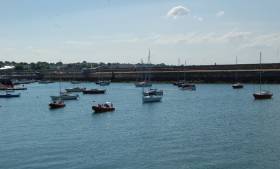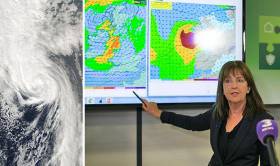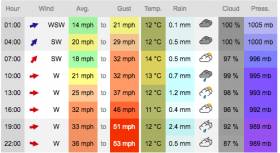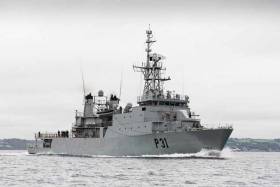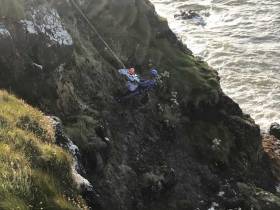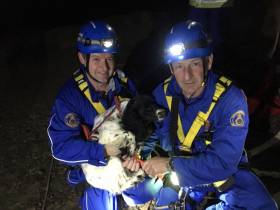Displaying items by tag: Coastguard
Are Sea Area Forecasts Necessary?
In this digital age, with so many available resources providing sea area weather forecasts, is there still a need for national radio to broadcast these forecasts?
I heard an RTE Radio Presenter asking a Met Eireann meteorologist on-air whether there was any point in broadcasting weather forecasts for the marine sector any more, because there was so much detailed weather information available online.
It reminded me of the battles I had with RTE Radio managers and schedulers when they came up with their idea of ending such weather forecasts altogether, because they took up broadcast time which could better used.
I was Marine Correspondent with RTE then so the conversation a few weeks ago between the RTE Presenter and Met Eireann reawakened my memories of those internal RTE disagreements and underlined for me how badly served the maritime sector is by the national media, both broadcast and print.
It also underlines why the BBC Radio Shipping Forecasts are popular amongst Irish fishermen, mariners, professional, commercial and leisure – because it’s a specialised service to the marine sector that RTE doesn’t provide in the same way.
The coastal radio stations of the Coast Guard give weather forecasts which are available at sea, thankfully, but the mindset of the RTE Presenter showed it was closed to around Dublin and Montrose and unaware of the reality of life, particularly in the maritime sector and the coastal communities, outside of urbanisation.
The Met Eireann Meteorologist told the RTE Presenter that there are coastal areas around the Irish shorelines and at sea where there is no internet access and not even a reliable mobile phone signal and that there is still dependence on the State broadcaster for the forecast.
That is a viewpoint I agree with, but one could add that the ‘independent broadcasters,’ those who are also described as national ‘commercial stations’ should also consider.
There has been a demand from the non-State public service broadcaster for a share of the licence fee, but that should also bring responsibilities, such as a sea area forecast for mariners.
Listen to the Podcast below:
Is it good enough that surfers, sailboarders, swimmers and yachtsmen put to sea, quite literally in the eye of a hurricane?
The overwhelming response online seems to be a resounding 'No'. There are now calls for legislation to penalise people who disobey advice from the Coastguard.
Despite warnings telling people to stay inside and avoid going near the sea, there have been numerous reports of people not paying any heed to this safety advice.
Taoiseach Leo Varadkar has said he will consider making it a criminal offence to ignore severe weather warnings as some people did during Storm Ophelia.
'People who disobeyed the red alert and travel warnings yesterday didn’t just put themselves at risk they also put at risk the lives of other people, particularly our emergency services. But I would never rush into creating a new crime. I think it is something that we will have to consider' “It was suggested today in the Dail that we would look at it on an all party basis and that’s what I’d like to do.”
Sinn Fein Transport Spokesperson Imelda Munster said: “It’s not just foolishness it’s recklessness.
“They are not only putting their own lives at risk they are also endangering the lives of all the voluntary bodies, who give up their own free time to save lives.
“They need to learn to have respect for them.”
The most serious, status red, weather warning was in place on Monday, meaning no boats should have been at sea.
Currently, Irish boaters enjoy a regulation free life afloat without the need for licences, insurance and few regulations. But is the foolhardiness of a few going to ruin it for the rest of the sailing and boating population?
A quarter of all RNLI call-outs in Ireland are to pleasure craft. Is there any excuse to put the lives of rescue service personnel at risk for something as basic as heeding warnings?
In the age of the smartphone, are sailors, clubs and organisations doing enough to kerb call outs of rescue services? Is boating a bad name with the Coastguard? Is all this leading to inevitable government control, when one of the reasons we go afloat in the first place is to escape the shackles of all the land-based regulations of the nanny state.
Is boat registration, as already indicated by Vardakar, during his time as Minister for Transport in 2013, an inevitable consequence of all this?
At the end of the day common sense and good seamanship from boaters would prevent a lot of call outs.
The price of freedom afloat is eternal vigilance.
Have your say in the Afloat.ie poll below and please feel free to leave your comment via Facebook below
- Votes: (0%)
- Votes: (0%)


| Total Votes: | |
| First Vote: | |
| Last Vote: |
Coast Guard Warns of Heavy Swell on Atlantic Coast
The Coast Guard advises caution to public as Met Éireann warns of heavy swell on Atlantic Coast later on Sunday.
Members of the public have been urged to heed the advice of the Coast Guard as Met Éireann has issued a status yellow wind warning with some very strong west, veering northwest winds expected to affect western and south western coastal counties later Sunday, overnight and into Monday morning with very high seas along the coasts during this period.
The Coast Guard advises the public to be careful on exposed coasts, cliffs and piers, harbour walls and promenades along the Atlantic seaboard particularly at high tide.
Remember to Stay Back, Stay High and Stay Dry.
If you see someone in difficulty in the sea, on the shore dial 999/112 and ask for the Coast Guard.
Coast Guard IMSARC Demo at Dunmore East a Success
Dunmore East in County Waterford was a hive of Search and Rescue activity this weekend, as the Irish Coast Guard co-ordinated a very successful day of Marine Search and Rescue demonstrations.
The exercise involved Ireland’s principal Search and Rescue (SAR) resources and assets and was a huge success as they tested themselves in a range of realistic scenarios with a particular focus on the interoperability of marine SAR resources.
Utilised Assets included the Waterford based Coast Guard Helicopter R117, Naval ship LÉ Eithne, the Air Corps Casa, Commission for Irish Light (CIL) Ship Granuaile and the Revenue Customs Cutter Faire.
Response teams were made up of:
The Dublin Fire Brigade Marine Emergency Response Team, Volunteer Coast Guard units, the RNLI, HSE’s Marine Ambulance Response Team, Irish Underwater Council (dive teams), Irish Water Safety, South East Mountain Rescue including rescue dogs and the Civil Defence.
Speaking after the event Gerard O’Flynn, the Coast Guard’s Search and Rescue Operations Manager said: “This exercise afforded the public a wonderful opportunity to see Ireland’s primary search and rescue resources conducting a series of realistic but challenging tasks, more importantly it enabled the Coast Guard to exercise interoperability between the different assets and agencies.”
The event included a series of water based safety demonstrations.
“Prevention and adherence to basic safety is the key element in minimising loss of life at sea and on our waterways,” explained SARs Manager Gerard O’Flynn.
Test scenarios included:
Offshore Search and Top Cover Exercise – with the MRCC in Dublin co-ordinating a Search by R117, the RNLI, Le Eithne with the Air Corps Casa providing ‘Top Cover’
On board Fire Emergency – LÉ Eithne acted as a Merchant Vessel (M/V) in distress with an on board fire, Rescue 117 transported the Dublin Fire Brigade Marine Emergency Response team.
Later R117 also transported the HSE Marine Response team to the LÉ Eithne.
Shoreline searches were initiated between Hook Head and Brownstown Head with Coast Guard Units, Naval Service reserves, Civil Defence personnel, divers from the Irish
Underwater Council and South East Mountain Rescue volunteers with SAR dogs tasked.
“The exercises and demonstrations were a success and I want to thank all the agencies and volunteer units who took part, and I want to particularly thank the Port of Waterford Harbour Master Capt. Darren Doyle and Dunmore East Harbour Master Capt. Harold McLoughlin for their assistance and co-operation in preparation for and the successful execution of the weekend activities, “ concluded Gerard O’Flynn.
Dunmore East To Host Irish Marine Search & Rescue Demo on Saturday
The public are encouraged to come and watch as Dunmore East is set to host some of Irelands principal Search and Rescue assets on Saturday the 2nd of September 2017. The event known as IMSARC Demo (Irish Marine Search and Rescue Demo) is co-ordinated by the Coast Guard and will feature a Coast Guard Helicopter, Naval ship LÉ Eithne, Air Corps Casa, Dublin Fire Brigade Marine Emergency Response Team, Volunteer Coast Guard units, CIL Ship Granuaile, the RNLI, HSE’s Marine Ambulance Response Team, Irish Underwater Council, Irish Water Safety, South East Mountain Rescue, Revenue Customs Cutter, and the Civil Defence.
The main event will commence at 10:30 with an off shore search demonstration, followed by an on-board emergency with the LÉ Eithne acting as a M/V in distress.
Demonstrations such as Cliff rescues, marine ambulance exercises and Casa Operations are at approx. 13.30 and will be visible from Dunmore East. A parade of all participating ships and boats supported by a Helicopter Fly past at 16;15 will present an interesting photo opportunity.
RNLI & Irish Coast Guard in Joint Call for People to ‘Respect the Water’ During Busiest Month for Rescues
The RNLI and the Irish Coast Guard are issuing a joint call this Bank Holiday weekend urging people to be vigilant and to take care on the water and along the coastline. It comes as both organisations note that August was the busiest month for coastal recreational incidents last year. Irish lifeboat crews last August alone responded 217 times to emergencies at sea.
With the summer holidays in full swing, it has been a busy time for the search and rescue agencies and this Bank Holiday weekend, the two organisations are warning people to be vigilant and take heed of some simple safety advice.
While summer air temperatures may be warm, Irish waters rarely exceed 15C, making them cold enough year-round to trigger cold water shock, which causes the instinctive reaction to gasp and swim hard, which can quickly lead to drowning.
As part of its drowning prevention campaign, Respect the Water, the RNLI is calling on the public to help save more lives during this busy period by remembering and sharing key survival skills.
Kevin Rahill, RNLI Community Safety Partner explains: ‘We are now half way through the summer holidays and are approaching what is traditionally a busy Bank Holiday weekend around the coast and on our inland waters. While that hopefully signals an enjoyable time for many – it sadly also means that we can learn of tragedy or hear of people getting into serious danger.
‘We want to start a national conversation that encourages people to fight their instincts around water, so we are asking people to remember and share two skills. The first is, if you see someone else in trouble; don’t go into the water yourself as you may also end up in serious danger. Instead, dial 999 or 112 and ask for the Coast Guard. If you want to help, find something that floats and throw it to them, or shout instructions on how to float until the rescue services arrive.
‘The second is, if you fall into cold water, fight your instincts to swim hard or thrash about as this could lead to drowning. Instead, relax and float on your back, keeping your airway clear, for around 60-90 seconds. This will allow the effects of cold water shock to pass so you can regain control of your breathing and then swim to safety or call for help. Just remembering these two simple points could help save your life, or someone else’s, this Bank Holiday weekend.’
The Irish Coast Guard has two simple messages, to ‘Stay Back, Stay High, Stay Dry’ near exposed parts of the coastline and to ‘Stay Afloat – Stay in Contact’ when at sea.
Gerard O’Flynn, Irish Coast Guard Operations Manager said: ‘While it is important that everyone going afloat wears a lifejacket, it is equally important that every user ensures their lifejackets are regularly serviced.
‘Lifejackets are not fool proof and users should always ensure that they have familiarised themselves on their proper operation and that they are in date for servicing. Anyone going afloat should also ensure they have a means of raising the alarm should they need to and that they ensure someone ashore is aware of their trip and estimated time of return.’
‘Away from the sea, we want everyone to exercise caution when walking on exposed cliffs. Pets should be always kept on a leash and walkers should avoid areas which they are not familiar with. Our message is to stay back, stay high, stay dry.’
Stranded Teen Rescued From North Coast Cliff Base
#Rescue - Coleraine Coastguard rescued a teenage girl who was stranded at the base of a 100ft cliff at Castlerock yesterday evening (Monday 24 July).
The coastguard rescue team was tasked to Castlerock following a report of two girls cut off by the tide, one of whom was reported as having been injured.
Ballycastle Coastguard, both Portrush lifeboats and RNLI lifeguards in the area were also tasked to assist.
The lifeguards managed to locate one teenage girl at the base of the cliff, just below the caravan park.
One lifeguard and one crew member from the inshore lifeboat landed on the rocks to assist the stranded girl, who was by that point hypothermic, distressed and exhausted from having tried to swim to safety.
She had also sustained a number of abrasions from making contact with the rocks.
Although the spring tide was rising rapidly, her condition made a rescue by sea very difficult. It was therefore decided to carry out a rope rescue.
A coastguard rope rescue technician descended the cliff and brought the stranded girl to safety, just as the waves broke over the rocky platform where she was stranded.
The teenager was soon reunited at the cliff top with her parents and with her friend, who had managed to swim to safety and had raised the alarm.
Both girls were taken to hospital by ambulance as a precaution against secondary drowning.
The coastguard later found two teenage boys had been with the girls, sustaining lacerations and abrasions as they tried to cross the rocks towards Castlerock beach.
Earlier in the evening, Coleraine Coastguard was tasked to White Rocks in Portrush where a four-year-old boy had sustained a head injury on the rocks.
On arrival it was found that the RNLI lifeguards on duty had assisted the child and delivered him into the care of the NI Ambulance Service.
Scottish Yacht 'Inis Mor' Sinks On Way to ICRA Championships at Royal Cork, All Crew Safe
The yacht that sank off Wexford yesterday afternoon was the Scottish–owned Ker 39 Inis Mor. The top performer was en route to the Irish Cruiser Racer Association (ICRA) National Championships that begin at Royal Cork Yacht Club in Cork Harbour on Thursday.
A social media post by the crew last night said: 'By now a lot of you may have heard the sad news. We are all glad that Clarke, Bob and Clara are safe and well. Unfortunately this afternoon Inis Mor sunk whilst on her way to Crosshaven. Clearly we are all absolutely gutted but very thankful to the [Coastguard] Rescue 117 helicopter crew who got the guys out the life raft and the Kilmore Quay RNLI team who came to assist'.
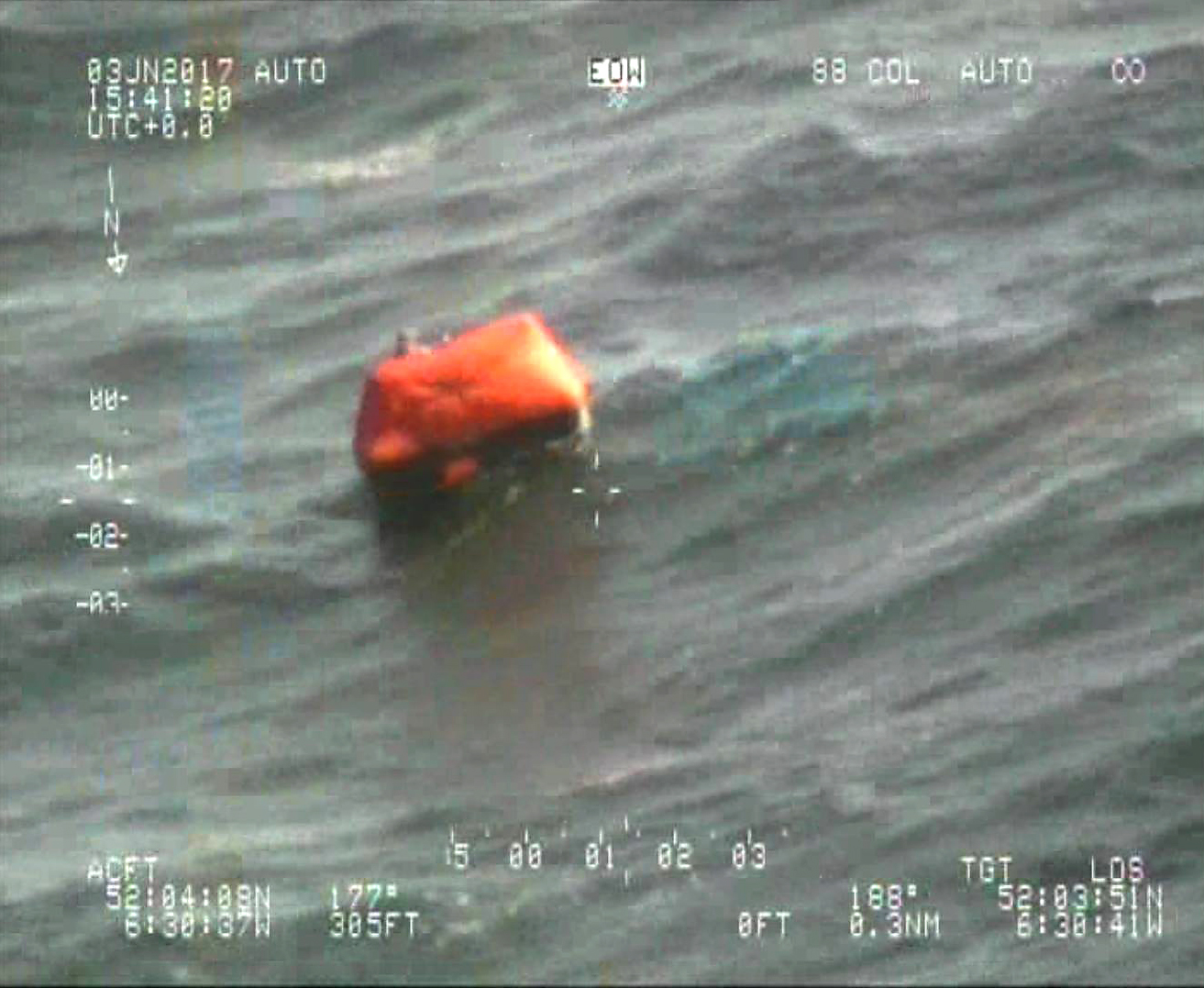 The crew, two men and a woman, evacuated to a liferaft (one crew visible top left of raft). Photo: Rescue 117
The crew, two men and a woman, evacuated to a liferaft (one crew visible top left of raft). Photo: Rescue 117
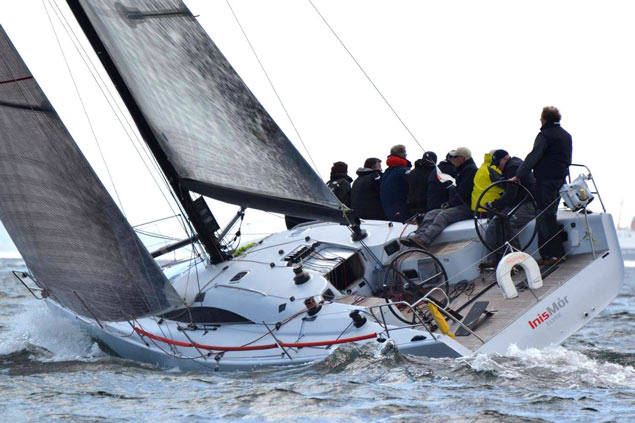 Clyde–based Inis Mor, a Ker 39, was due to race at the ICRA championships on Thursday. Photo: Facebook/Inis Mor
Clyde–based Inis Mor, a Ker 39, was due to race at the ICRA championships on Thursday. Photo: Facebook/Inis Mor
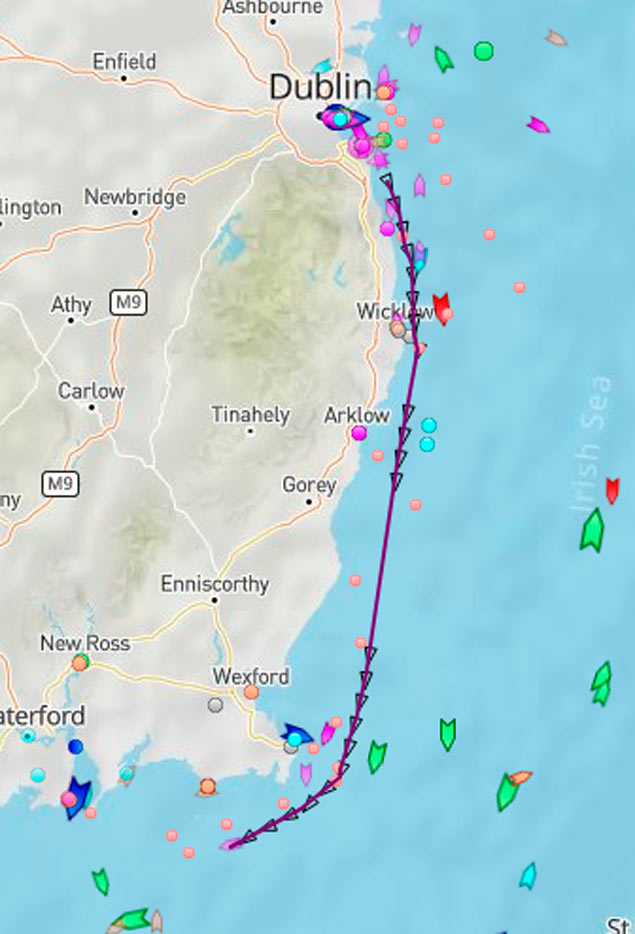 The yacht made good progress from the Clyde to Scotland and called in to Dun Laoghaire on its passage down the Irish Sea. Screengrab: Marine Traffic
The yacht made good progress from the Clyde to Scotland and called in to Dun Laoghaire on its passage down the Irish Sea. Screengrab: Marine Traffic
As Afloat.ie reported earlier, the three sailors were rescued by Coastguard Helicopter and brought to Waterford airport.
Rescue 117 reported it was tasked to a yacht sinking off the Saltee Islands on social media: 'The yacht crew had issued a Mayday call and had taken to their life-raft. The life-raft was spotted 11 miles away by our winchman on the FLIR (Forward Looking Infrared) camera. Rescue 117 winched the three crew from the life-raft to the safety of the aircraft. They did not require any medical attention. Kilmore Quay lifeboat were also on scene. The yacht sank shortly after'.
The yacht, one of several international competitors travelling to the event, was one of four competing in Class Zero of the Cork Harbour based Championships. Read Afloat.ie's ICRA Runners and Riders event preview here.
Inis Mor is a 39–footer and a previous winner of the Round Ireland Race.
Kilmore Quay RNLI attempted to keep the yacht afloat with pumps after it began to sink in ten–foot swells off the Saltee Islands.
 Yesterday's Facebook post on social media from onboard confirmed Inis Mor's location on the south coast and her final destination but just hours later the yacht sank (below) Screengrab: Marine Traffic
Yesterday's Facebook post on social media from onboard confirmed Inis Mor's location on the south coast and her final destination but just hours later the yacht sank (below) Screengrab: Marine Traffic
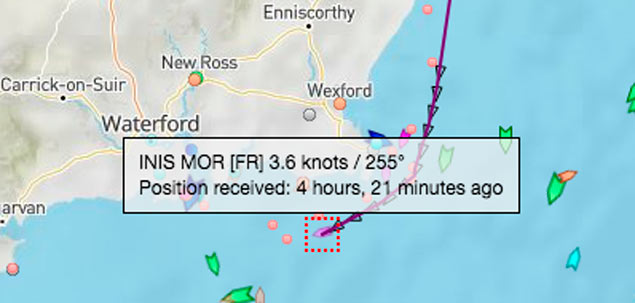
The Clyde–based yacht was was one of the biggest boats entered in the ICRA championships and was to compete at the three-day annual regatta starting on Thursday.
Afloat.ie sources say problems started when a toilet cracked on board and this led to the water ingress.
Three UK sailors, two men and a woman, were rescued off the Wexford coast this afternoon after their 39–foot yacht got into difficulty.
The yacht sank quickly after a toilet fractured and it started taking on water in ten–foot swells off the Saltee Islands.
The yacht began to sink and a Mayday call was made after three o'clock.
The search and rescue helicopter from Waterford airport managed to take the crew from the water. Kilmore Quay RNLI lifeboat also attended.
According to RTE.ie news, the three crew were brought to Waterford airport and did not need to go to hospital.
An RNLI spokeswoman told Afloat.ie: 'Three onboard evacuated into life raft where they were rescued by Waterford Coast Guard Helicopter. Kilmore Quay RNLI went onboard to try and pump water off the yacht and recovered the liferaft'.
#Rescue - Coastguard units from Ballycastle and Coleraine were tasked on Friday night (26 May) to the aid of a dog fell more than 30 feet off a cliff near the Giant’s Causeway in Co Antrim.
The coastguard teams used their specialist rope rescue equipment to lower a technician down the cliff to secure Bell the springer spaniel and lift her up to her grateful owners.
Belfast Coastguard reminds anyone with pets on or near the water to keep them on leads, especially close to cliffs. If an accident should happen, don't attempt a rescue yourself – always call the coastguard who are trained for the purpose.
In other news from the North Coast, the iconic Carrick-a-Rede rope bridge is closed until further notice after vandals attempted to cut it down.
TheJournal.ie has more on the incident last week, as the National Trust awaits investigation by structural engineers to determine the extent of the damage to the coastal tourism attraction.


























